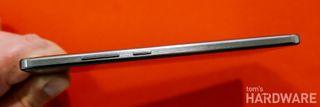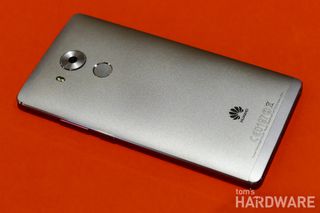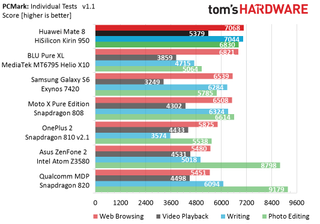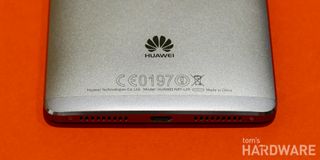Huawei's Mate 8 6-inch Phablet Coming To North America, We Go Hands On [Updated]

Huawei’s recent success in the North American market is an unlikely of a success story as can be. It's a brand with no consumer cachet here, blessed with a name that many still have trouble pronouncing (it’s “wah-way”). However, it is one of the biggest smartphone OEMs globally, hugely successful in its Chinese home market, and its presence in European markets has been growing. Its biggest achievement so far, though, was the vote of confidence Google gave Huawei by picking it to be the manufacturer of one of its two Nexus phones this year.
Back in November, Huawei announced the latest phone in its Mate series of phablets, the Mate 8. These phones are usually only sold in China, and a handful of other Asian and European markets, but flush with the reception that the 6P received, it looks like Huawei thinks that the U.S. market is ready for a Huawei-branded premium device. Today’s CES announcement marks the global launch of the Mate 8 (which Huawei is optimistically dubbing the “ultimate high-end smartphone”), including North America.

Along with a U.S. release, the other big story of the Mate 8 is its SoC. Huawei is like the other giant on the Android OEM phone block in that it also makes its own SoCs, and the Mate 8 is powered by the new 16nm FinFET+ HiSilicon Kirin 950 chip. This is one of the first SoCs that uses ARM’s powerful new Cortex-A72 microarchitecture, which is expected to be one of the best performing mobile CPUs of 2016.
Huawei was kind enough to let us get our hands on a Mate 8 before today’s announcement, and in the short time we’ve had it, we’ve been able to run our full suite of performance tests on it. Right now, we are giving you a first look at the Mate 8 and also a teaser as to its performance, which (spoiler alert) is impressive to say the least.
Specifications
| HUAWEI NXT-L29 | HUAWEI NXT-L09 | |
|---|---|---|
| Size | Height: 157.1mm; Width: 80.6mm; Depth: 7.9mm; Weight: 185g | Height: 157.1mm; Width: 80.6mm; Depth: 7.9mm; Weight: 185g |
| Colors | Moonlight Silver; Space Gray; Champagne Gold; Mocha Gold | Moonlight Silver; Space Gray |
| Display | 6-inch FHD 1080p (1920 x 1080) Screen, 368ppi 16.7M colors, color saturation (NTSC) 95%, High contrast 1500:1 | 6-inch FHD 1080p (1920 x 1080) Screen, 368ppi 16.7M colors, color saturation (NTSC) 95%, High contrast 1500:1 |
| CPU | HUAWEI Kirin 950 (64-bit,16nm FinFET+), Octa-core (4 x 2.3 GHz A72+ 4 x 1.8 GHz A53) + i5 co-processor | HUAWEI Kirin 950 (64-bit,16nm FinFET+), Octa-core (4 x 2.3 GHz A72+ 4 x 1.8 GHz A53) + i5 co-processor |
| GPU | Mali-T880 MP4 | Mali-T880 MP4 |
| OS | Android Marshmallow 6.0 with EMUI 4.0 | Android Marshmallow 6.0 with EMUI 4.0 |
| Memory | 3GB RAM + 32GB ROM or 4GB RAM + 64GB ROM | 3GB RAM + 32GB ROM |
| Network | 4G TDD LTE: Band 38/39/40 4G FDD LTE: Band 1/2/3/4/5/6/7/8/12/17/18/19/20/26 | 4G TDD LTE: Band 38/39/40 4G FDD LTE: Band 1/2/3/4/5/6/7/8/12/17/18/19/20/26/28 |
| Dual SIM | Dual SIM Supported | N/A |
| GPS | GPS/A-GPS/Glonass/BDS | GPS/A-GPS/Glonass/BDS |
| Connectivity | Wi-Fi 2.4G/5G, a/b/g/n/ac with Wi-Fi Direct support BT4.2, support BLE MicroUSB (High Speed USB) | Wi-Fi 2.4G/5G, a/b/g/n/ac with Wi-Fi Direct support BT4.2, support BLE MicroUSB (High Speed USB) |
| Sensors | Fingerprint Sensor, G-Sensor, Gyroscope sensor, Compass, Ambient Light Sensor, Proximity sensor, Hall sensor, Barometer | Fingerprint Sensor, G-Sensor, Gyroscope sensor, Compass, Ambient Light Sensor, Proximity sensor, Hall sensor, Barometer |
| NFC | NFC supported | NFC supported |
| Audio | Bottom-facing speakers | Bottom-facing speakers |
| Camera | Main camera 16MP 1/2.8" Sony Exmor RS IMX298, 1.12 μm pixels, f/2.0 with OIS (optical image stabilization), Dual-tone flash, PDAF+CAF auto focus Video recording: 1080p, 60 fps support 720P 120FPS Slo-Mo recordingFront camera 8MP, f/2.4 Photos: max 3264 x 2448 pixels Video recording: 1080p, 30 fps | Main camera 16MP 1/2.8" Sony Exmor RS IMX298, 1.12 μm pixels, f/2.0 with OIS (optical image stabilization), Dual-tone flash, PDAF+CAF auto focus Video recording: 1080p, 60 fps support 720P 120FPS Slo-Mo recordingFront camera 8MP, f/2.4 Photos: max 3264 x 2448 pixels Video recording: 1080p, 30 fps |
| Battery | 4,000 mAh (non-removable) | 4,000 mAh (non-removable) |
| In the box | Handset; Headset; Charger; USB cable; Quick Start Guide; Safety Information | Handset; Headset; Charger; USB cable; Quick Start Guide; Safety Information |
The specification charts we were provided show two models of the Mate 8, and it’s not clear in which markets each model will be available. The model we’ve been playing with is the dual-SIM NXT-L29 with 3 GB of RAM and 32 GB of storage. This model is optionally available with 4 GB of RAM and 64 GB of storage, and it's the model on sale in China as far as we know.
Beautiful Premium All-Metal Design
Design-wise, the Mate 8 uses the unibody aluminum construction that Huawei has basically perfected. Its design language should be familiar to anyone who’s seen a Nexus 6P, complete with the circular fingerprint reader. The Mate 8’s screen is a lot bigger, though, at 6 inches, which is pushing the upper limits of what’s considered acceptable to North American consumers. However, the Mate 8 also has super-thin bezels and an incredible screen-to-body ratio of 83%. This makes the Mate 8 shorter that the 5.7-inch 6P. When using it, it never feels like you’re using a phone with such a big display.

In contrast to most current flagship smartphones, the Mate 8’s screen is only 1080p, although in the end we couldn’t see much difference between this display and that of all the QHD phones we’ve been using. The Mate 8’s 368ppi clearly demonstrates that once you get about 350ppi, you don’t really notice the pixels.
Stay on the Cutting Edge
Join the experts who read Tom's Hardware for the inside track on enthusiast PC tech news — and have for over 25 years. We'll send breaking news and in-depth reviews of CPUs, GPUs, AI, maker hardware and more straight to your inbox.
Huawei Continues Its Photographic Excellence
Before we get into a performance preview of the Mate 8 and Kirin, the other significant component of the Mate 8 is its camera. It uses Sony’s brand-new Exmor RS IMX298 sensor (and is the only phone that does, so far), a chip that is philosophically quite different than the Google-mandated 12MP IMX377 sensor used in the Nexus 6. The 377 favors a lower MP count with a big sensor to create large (1.55 μm) pixels than capture more light. The size of these pixels is large enough that Google dispensed with OIS on the 6P.

The IMX298 is more of a traditional smartphone camera sensor, smaller in size with smaller pixels, so OIS is a necessity, and found on the Mate 8, along with fast-phase detect autofocus. Although we haven’t been able to put the camera through its paces properly, our first impressions are positive. It's also important to note that the physical camera hardware is only half the story when it comes to final picture quality. The ISP (image sensor processor) also plays a big role, and Huawei apparently assembled a team of 300 engineers and spent $98 million to ensure that the ISP in the Kirin 950 was up to snuff. At first glance, it looks like that was money well spent.
How Does It Perform?

Very well, actually. The first result above is PCMark’s Work Performance that measures overall system performance by running a series of realistic workloads. In this test, the Mate 8 and Kirin 950 outperformed every device we’ve tested so far, including the pre-release Snapdragon 820 in the Qualcomm mobile development platform we tested.

When you look at the individual PCMark test scores, the Mate also does very well.

The Mate 8 has a huge 4,000 mAH battery, and Huawei claims that it “delivers industry-leading power efficiency offering over two days of normal usage.” We believe them. Looking at the results above, the Mate 8 clearly outlasts every phone we’ve tested.
There is one negative aspect we want to point out now: Its Mali-T880 MP4 GPU isn’t particularly powerful, especially for a premium flagship phone. This isn’t due to its architecture, because like the A-72 CPUs, it’s brand new. It is the result of Huawei deciding to go with only a 4-core GPU in the 950. That means that despite its incredible overall system performance, the Mate 8 isn’t exactly a mobile gaming powerhouse, and this does explain the choice to stick with a 1080p display.
It Comes With Marshmallow but…
Let’s get the good news out of the way first. The Mate 8 does run Android 6.0 Marshmallow. Unfortunately, it isn’t stock Android, like on the 6P. It uses a new version of Huawei’s standard E Emotion UI (EMUI), and it’s clear that this UI is more designed for its home market. Like many Chinese OEM OSes, it blends elements of iOS and Android, so there is no application drawer, all your program icons reside on your homescreen, and it uses its own notification system, instead of the standard Android one introduced with Lollipop.

This is the one aspect of the Mate 8 that I can’t get behind, and while EMUI is by no means an unattractive UI, and is packed with some useful and intelligent features that go beyond the functionality of standard Android, I still found myself installing a third-party launcher to make it usable for me. Because we were testing a unit running pre-release software, we have encountered some bugs and issues, but it would be unfair to ding Huawei for this. Beta software isn’t supposed to be perfect, so we can’t pass final judgment on the Mate 8’s software until we’ve played with the final version.
Color Us Impressed
Our initial thoughts about the Huawei Mate 8 are very positive. This phone shows that the Nexus 6P wasn’t a fluke and that Huawei is capable of producing a world-class smartphone without having to partner with Google. The Mate 8 is blisteringly fast thanks to its Kirin 950 SoC, and it has excellent battery life and a great camera. Our only reservations about it so far are to do with its EMUI, but seeing as we were testing out a Chinese market model running unfinished software, we’re sure that Huawei will address many of the issues we have with it. Don’t expect EMUI to come with an app drawer anytime soon.

Presently, we don't know the Mate 8’s pricing, nor when it will be coming to North America. Hopefully, we’ll know more soon on that front.
Update, 1/05/16, 12:15 pm PT: At today’s CES press conference Huawei announced that the Mate 8 will be available “globally” and will be €599 for the 3 GB/32 GB model and €699 for the 4 GB/64 GB model. That works out to approximately $650 and $750, respectively.
Unfortunately, it looks like for now it isn’t officially coming to North America, and there it will certainly not be sold by any carriers. However, it is fully compatible with all North American cellular bands, and we were told that you can still buy it online to use it in the U.S. and Canada. We aren’t sure if this means if it will be sold directly by Huawei or if you’ll have to go through an online retailer.
-
InvalidError I wonder for how much longer the ultra-high-end phone market will survive with Asus starting to aggressively push many of the same high-end specs in the $200-350 range. I hope more manufacturer will follow.Reply
I almost bought a 551KL but passed when I found out it only had single-band N since 2.4GHz is too crowded in my neighborhood for reliable VoIP. -
hitman400 ReplyI wonder for how much longer the ultra-high-end phone market will survive with Asus starting to aggressively push many of the same high-end specs in the $200-350 range. I hope more manufacturer will follow.
High end spends =/= high end phones. High end phones encompass specs, one of many things.
I almost bought a 551KL but passed when I found out it only had single-band N since 2.4GHz is too crowded in my neighborhood for reliable VoIP. -
targetdrone There was a time when Google was selling $600 specs for $300, now look at the cost of a Nexus. I don't think Asus will be able to keep it up for long.Reply -
InvalidError Reply
Why wouldn't they be able to keep them up? A $80 Android phone already has all the fundamental components of a $700 phone. The BoM difference between that and a $200 551KL is likely less than $70 ($20 for the RAM, $10 for the display, $10 for the SoC, $10 for the cameras, $20 for miscellaneous other stuff), which means Asus is pocketing around $50 extra per sale there. From there to uber-high-end phones, it is only another $70-100 on the BoM or so, mostly to beef up the specs of individual components, a 300-500% incremental markup. Asus can keep it up for however long as they want to grow their market share since they are making a fairly decent profit on each sale as it is.17264835 said:There was a time when Google was selling $600 specs for $300, now look at the cost of a Nexus. I don't think Asus will be able to keep it up for long.
The only reason Google ended up charging $600 for their new phones and tablet is because they decided to re-purpose the Nexus brand from its original value-oriented and developer-friendly Android launch platform brand to a premium consumer brand priced to match its intended competitors.
Most Popular



